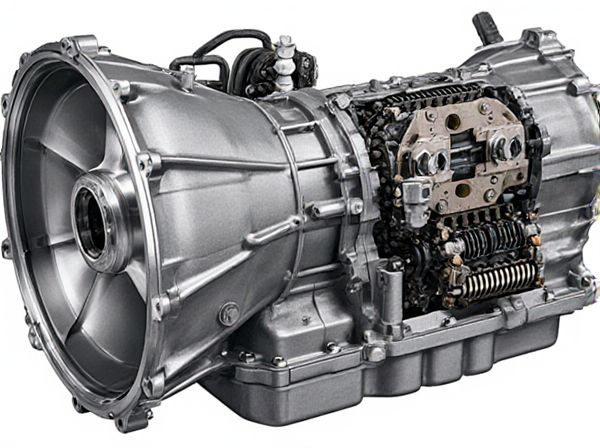
Photo illustration: Wet Clutch Transmission vs Dry Clutch Transmission
Wet clutch transmissions offer better heat dissipation and smoother engagement due to oil lubrication, making them ideal for heavy-duty and high-performance vehicles. Dry clutch transmissions are lighter and more efficient because they operate without oil, providing quicker response but generating more heat and wear during use. Your choice depends on your vehicle's performance needs and maintenance preferences.
Table of Comparison
| Feature | Wet Clutch Transmission | Dry Clutch Transmission |
|---|---|---|
| Clutch Type | Oil-immersed, lubricated by transmission fluid | Air-cooled, operates without fluid |
| Heat Dissipation | Efficient, due to fluid cooling | Less efficient, prone to overheating |
| Durability | High, less wear thanks to lubrication | Moderate, higher wear from friction |
| Performance | Smoother engagement, better for high-torque vehicles | Quicker engagement, suited for lightweight, sporty cars |
| Maintenance | Requires periodic fluid changes | Minimal, no fluid required |
| Efficiency | Lower due to fluid drag | Higher, less energy loss |
| Common Applications | Motorcycles, high-performance cars, off-road vehicles | Sportbikes, compact cars, racing vehicles |
Introduction to Clutch Transmission Systems
Clutch transmission systems transfer engine power to the drivetrain through either wet or dry clutches, each designed to optimize performance and durability under different conditions. Wet clutch transmissions operate with oil immersion, enhancing cooling and reducing wear, making them suitable for high-load applications like motorcycles and heavy machinery. Dry clutch transmissions function without oil, providing quicker engagement and lighter weight, often preferred in sports cars and manual transmission vehicles for improved responsiveness.
What Is a Wet Clutch Transmission?
A wet clutch transmission uses clutch plates submerged in oil, enhancing heat dissipation and reducing wear, which results in smoother engagement and longer lifespan compared to dry clutches. Commonly found in motorcycles, ATVs, and some automatic transmissions, wet clutches provide better cooling through continuous lubrication. This design improves performance under high loads and frequent shifting, making it ideal for applications requiring durability and consistent power transfer.
What Is a Dry Clutch Transmission?
A dry clutch transmission uses a clutch system without oil or lubricant, relying on direct friction between the clutch plate and flywheel to transfer power from the engine to the drivetrain. This type of transmission offers a more immediate response and greater efficiency due to reduced slippage and heat dissipation compared to wet clutch systems. Dry clutch transmissions are commonly found in motorcycles and performance vehicles where precise power delivery and weight savings are critical.
Key Differences Between Wet and Dry Clutch Transmissions
Wet clutch transmissions use oil to cool and lubricate the clutch plates, resulting in smoother engagement and longer lifespan, especially under heavy loads. Dry clutch transmissions operate without lubrication, offering quicker response and higher efficiency but tend to wear out faster due to heat buildup. The choice between wet and dry clutch systems depends on factors like vehicle type, driving conditions, and maintenance preferences.
Performance Comparison: Wet vs Dry Clutch
Wet clutch transmissions offer superior heat dissipation and smoother engagement due to being immersed in oil, enhancing durability and reducing wear under high-load conditions. Dry clutch transmissions provide a more direct power transfer and lighter weight, resulting in quicker throttle response and better performance in racing or high-performance applications. The choice between wet and dry clutches depends on balancing heat management, durability, and power delivery requirements for specific vehicle uses.
Durability and Maintenance Considerations
Wet clutch transmissions offer greater durability due to continuous lubrication by oil, which reduces wear and enhances cooling, making them ideal for high-performance and heavy-duty applications. Dry clutch transmissions, while simpler and lighter, tend to experience faster wear and require more frequent maintenance since they rely on air cooling and lack oil immersion. Maintenance considerations for wet clutches involve regular oil changes to prevent contamination, whereas dry clutches demand periodic inspections and adjustments to manage friction surface degradation.
Cost Analysis: Wet Clutch vs Dry Clutch
Wet clutch transmissions generally incur higher initial costs due to complex design and the need for continuous lubrication systems, but offer longer lifespan and reduced maintenance expenses. Dry clutch transmissions have lower upfront costs and simpler construction, yet demand more frequent replacement and can suffer from quicker wear under high load conditions. Overall cost analysis favors wet clutches for heavy-duty applications, while dry clutches remain cost-effective for light vehicles with less demanding driving cycles.
Applications in Motorcycles and Automobiles
Wet clutch transmissions, commonly found in motorcycles and some automobiles, excel in high-performance and off-road applications due to their enhanced cooling and durability from oil immersion. Dry clutch transmissions, preferred in racing motorcycles and lightweight vehicles, offer quicker engagement and reduced drivetrain losses but require frequent maintenance due to higher wear. Both clutch types influence vehicle performance, with wet clutches providing smoother operation and dry clutches enabling more immediate power transfer and responsiveness.
Pros and Cons of Wet Clutch Transmission
Wet clutch transmissions offer superior cooling and enhanced durability due to continuous lubrication with oil, which reduces wear and heat buildup during operation. These transmissions provide smoother engagement and are better suited for high-performance vehicles or heavy-duty applications where frequent gear shifts occur. However, the presence of oil can cause slight power loss and increased complexity, leading to higher maintenance costs compared to dry clutch systems.
Pros and Cons of Dry Clutch Transmission
Dry clutch transmissions offer improved fuel efficiency and lighter weight compared to wet clutches, enhancing vehicle performance and responsiveness. However, they tend to generate more heat and noise, leading to quicker wear and requiring more frequent maintenance. The absence of oil cooling in dry clutches can cause reduced durability under high-stress conditions, limiting their suitability for heavy-duty or high-torque applications.
 caratoz.com
caratoz.com